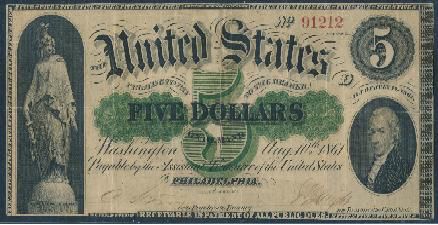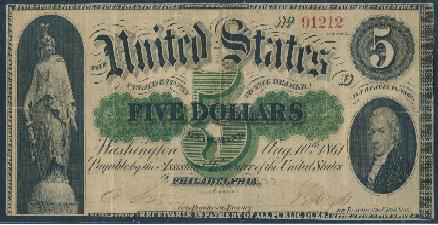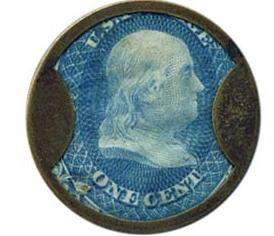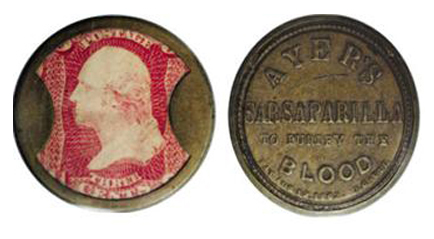Encased Postage Stamps: The “New Metallic Currency”

Of the many shortages of goods and services in the early years of the U.S. Civil War, none was more interesting than the shortage of coins and the enterprising and creative solutions to remedy that shortage using postage stamps.
In 1862, paper money was not backed by gold or silver and, therefore, it was only a very tenuous faith in the Government that gave people any assurance that paper money had true value. Most people didn’t want to embrace that faith. Combine that feeling with the uncertainty associated with the ultimate outcome of the civil war and, hence, the hoarding of common gold, silver, and copper coinage, the time-tested, universally accepted exchange medium.

This hoarding situation was worsened by clever financial traders who would buy U.S. silver coins using paper money. These coins would then be sold to foreign markets in exchange for gold, a much more valuable commodity. By mid-1862, it was estimated that $25 million in coinage had disappeared from circulation in the United States.
But people still needed to purchase a 3¢ loaf of bread, a 1¢ newspaper, a 5¢ quart of milk and countless other goods that required coins. And vendors had to make change when an item’s price was less than a nickel, a dime or a quarter. How was this to be done?
In some cities, businesses gave customers I.O.Us, private companies created “Civil War tokens” and paper money was cut into several pieces to represent a fraction of a dollar. Clever remedies for sure, but none that were widely used or accepted.
All of this radically changed on July 17, 1862, when Congress decided to address the coinage shortage and passed a law that allowed postage stamps to satisfy debts of less than $5, but only debts to the government. As probably the first case of an “urban myth”, the public grossly misinterpreted this to mean that postage stamps could be universally used in lieu of coins for any type of debt or purchase. Through various newspaper announcements and other mediums, the government attempted to educate the populace as to their misunderstanding, but to no avail.
People began to carry stamps in their purses and pockets and used them repeatedly for daily purchases. Vendors gladly accepted the stamps as payment. But all of this hand-to-hand usage quickly resulted in damaged stamps with denominations sometimes unrecognizable. The local post offices would not exchange damaged stamps for new ones, so a remedy was needed. John Gault, a New York entrepreneur, decided he had the best solution.
On August 12, 1862, Gault obtained a patent for a “postage stamp case”, or as he named the item in a newspaper advertisement, the “New Metallic Currency.”

Machines used to make buttons was the fundamental component in Gault’s idea. Starting with a round piece of brass (about the size of a quarter) as the backing, and then layering on a piece of cardboard, a stamp, a piece of mica (as a clear covering for the stamp) and finally another piece of brass with a hole in it, the button machine would press all of the pieces together to create the encased stamp. The final step in the process was for the machine to bend over the edges of the frame to keep all of the pieces inside the case.
Gault didn’t sell the encased stamps to the public. Instead, he sold them to stores and businesses that needed “coinage” to make change for customers’ purchases. Gault’s profit came from the 20% markup over the face value of the stamp.
To increase his potential profit, Gault’s second idea was to inscribe advertising on the back of the encased stamp. He would charge companies who purchased the metallic currency an additional 2¢ for each item. In time, 31 merchants signed up with Gault including Joseph L. Bates (fancy goods), Drake’s Plantation Bitters (a “medicine” mainly consisting of rum), the Tremont House, North America Life Insurance and Aerated Bread.

Gault’s most significant client was J.C. Ayer, a manufacturer of “medicines” and medical remedies. Ayer was well versed in the advantages of keeping a product’s name in front of the public as he had done with newspaper advertising and almanacs. So, many of the existing encased stamps today are the Ayer varieties since a large number were produced.
Encased stamps were widely accepted in the general commerce realm until later in 1862 when the government issued “fractional currency”, i.e., bills with values of less than one dollar. This legitimate, government-sanctioned currency quickly eliminated the coin shortage. Having no other value than the stamp, people tore apart the encasements of their metallic currency to remove the stamp to use as postage. Thus the scarcity of the 1862 encased stamps today.
